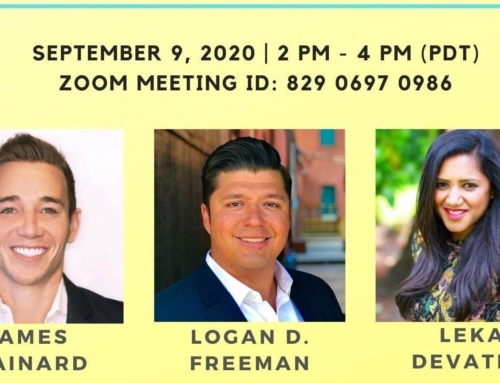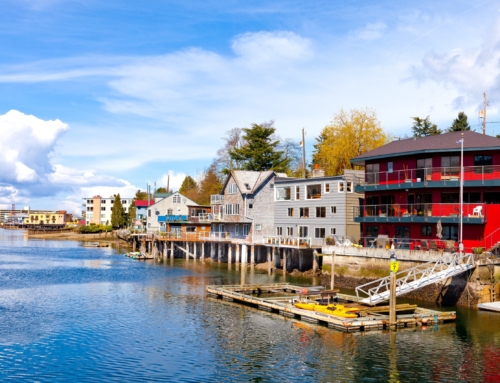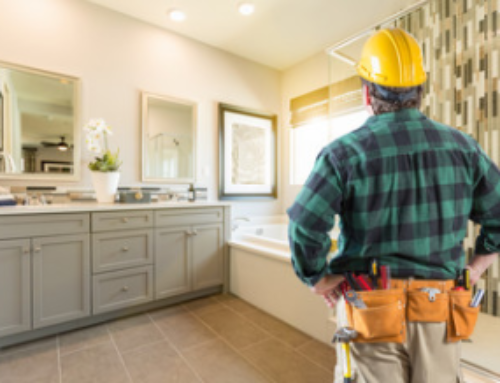Co-founder of Heaton Dainard, James Dainard, was recently featured on The Best Ever Show, a podcast with host Joe Fairless. On the show, James and Joe discuss how to evaluate the profitability of a deal, some strategies on how to navigate permit and construction issues, and James details some personal experiences he has had with creating rental income for himself.
Listen to the podcast below, or you can read the full transcript of the interview by scrolling down. To check out more of Joe’s shows, head over to The Best Ever Show page. To find out more about Joe and what he does, check out JoeFairless.com for more.
Transcript
Joe Fairless: Best Ever listeners, how are you doing? Welcome to the best real estate investing advice ever show. I’m Joe Fairless, and this is the world’s longest-running daily real estate investing podcast, where we only talk about the best advice ever, we don’t get into any of that fluffy stuff. With us today, James Dainard. How are you doing, James?
James Dainard: I’m doing well, man. Thanks for having me on. I’m excited to talk to the best listeners ever.
Joe Fairless: That’s right. Well, I’m looking forward to our conversation. A little bit about James – he is the co-founder of Heaton Dainard, a full-service real estate brokerage specializing in long-term wealth and financial stability for clients. He was honored as co-founder of one of Washington’s fastest-growing private companies in 2013, 2014, 2015, 2016, and Inc. 5000’s Fastest Companies in America. Based in Bellevue, Washington, a place I spent a decent amount of time in six years ago. I would always go to the Bing and MSN offices in Bellevue… So with that being said, James, do you wanna give the Best Ever listeners a little bit more about your background and your current focus?
James Dainard: Yeah. My background is I actually started in real estate when I was a senior college, 22 years old; I was waiting tables and I started working for an investment company in the wholesale market… Going out and knocking on doors, getting them contracts and selling them off. What my main focus is is really working with investors on identifying how to maximize the returns in their current portfolio, or finding them new portfolios to acquire, whether it’s 1031 exchanges to increase their annual cash flow, or to just increase their portfolio with liquidity, cash flow rentals… And then we do a lot of fix and flip properties and training with investors, kind of teaching them the guts of it about construction management specs, and then getting them sold.
Joe Fairless: Wow, okay. So let’s talk about maximizing returns on a portfolio… What are some mistakes you see investors or people make?
James Dainard: Some mistakes, and mistakes that I’ve done myself, is sometimes creating an asset – if I have a current performing asset, and it maybe gets me a 7% or 8% return, and I go to buy something new, or trade in with something new that might give you a 10% return.
One thing I learned over the last couple of years – and we’ve kind of adjusted our strategy based on this – is once you buy that next building, you might get a nice equity position, you’re increasing your cash flow, but you’ve gotta pay attention to the dead time on your money. How long are you out that income when you make that trade to get the repairs and renovation done?
So what we kind of do now is we factor in our dead time of loss of income for that 10-12 months that these projects can take. So that’s one thing investors should always pay attention to – it’s not just the cash flow, but what’s your overall return over a 10-year basis.
Joe Fairless: And what are some tips you have for people listening in order to calculate that accurately?
James Dainard: Build yourself a good spreadsheet. We have a good rental spreadsheet… So when we do a trade, we don’t just break down the cash flow, but then we break down the cash flow and loss of income during the renovation period… So for us, we actually have everything set up on a two-tier refinance calculator. One when we enter the new asset with hard money, and then holding times during that time, calculating your annual taxes, utilities – all costs that you might overlook at first…
And then it then turns it into a refinance, where we go into the BRRRR type strategy, where we’re refinancing out all of our cash, or a majority of our cash, or how much cash we were weaving in… But based on that first set of free finance calculations, we can really see what our loss of income is during that time. I’m more than happy to always provide that spreadsheet to people, but it’s about really just paying attention and then building your financial tools around your business model.
Joe Fairless: And just to give us an example of a couple transactions you’ve recently done… What are some examples?
James Dainard: An example… Recently when I did a trade – I actually sold four rental properties, and then I 1031-exchanged them into a triplex/pseudo-rooming house… So two units will be conforming units, and then the third unit is gonna be an 8-bedroom rooming house. It’s right next to the University of Washington, so it has high rent potential… So like I was just talking about, one thing I had to get comfortable with and make sure the trade was worth it is I took three properties that were making about 7%-8%, and then I have about 12-months’ worth of renovation, of dead time… So I’m losing about 60k in income on all three properties… But I went from making a 7%-8% return to now after the property is completely stabilized I’m going into a 14% cash return, with a really good equity position, in a really good neighborhood (I’m also trading into a better neighborhood). So for me the dead time and the money was worth the trade.
Now, if it would have been a 10% return trade, I probably would have passed on it at the end of the day. So I had to really adjust my numbers for this scope of work that I was doing.
Joe Fairless: You probably would have passed a 10% even though it’s in a better area, and that dead time is a one-off variable, not a constant variable?
James Dainard: Yeah, because for me, if I’m gonna make the trade, I wanna make sure it’s a next-five-year trade. So anytime I’m looking at maybe some awesome assets – and I liked my three rental properties that I had; they weren’t under-performers by any means, and they were in good locations, but for me if I’m gonna go through selling off all my assets, putting it in and having that dead time, I wanna make sure it’s worth it. So for me, I always factor about a 4% increase on my trade.
Now, if it would have been a lot easier building, which I could have renovated in a three-month period, I would have gone for a maybe 10%-11% trade. But the scope of work dictated the return I was trying to trade.
Joe Fairless: Talk us through the renovation project, please.
James Dainard: The renovation – one unit is very straightforward, I’m doing electric plumbing. It’s a one-bedroom/one-bath unit. I can’t do a whole lot more with that, so I’m just hitting all the systems, getting them safe, getting it updated to maximize rents. The current rents on the property were $1,395, and I can get them up to $1,995 with about a $20,000 renovation.
The second unit is a two-bedroom/one-bath that the guy had partially demo-ed already… It’s about 900 sq ft, and I’ve kind of laid out how I can get a three-bedroom/one-bath unit, which takes a lot more framing and design layout. I basically have to gut the whole thing upstairs… But it takes my rent potential from being about $2,200 to $3,400. So for me doing the [unintelligible [00:07:00].26] that third bedroom brought a substantial more income to me on that unit.
And then the third unit is actually a two-bedroom/one-bath, that brings in about $2,100/month, and I’m actually converting that out into an eight-bedroom rooming house… Because it’s a triplex, it only allows me to get eight bedrooms per unit. In this one I had a large, unfinished basement, so I’m digging out part of the basement and adding about six bedrooms in the basement area. It’s a very substantial renovation.
How I had to plan that renovation – it takes so much time, effort and resources that I wanted to make sure I got that return out of it. But that eight-bedroom rooming house will rent for about $995/room. So that bottom unit alone is gonna bring in $8,000. The one-bedroom/one-bath is gonna bring about $1,895, and then the top floor unit is gonna bring in about $3,200 to $3,400/month.
Joe Fairless: So the first one, the one-bedroom/one-bath you’re doing electric and just some mechanical stuff, you’re increasing rent from basically $1,400 to $2,000, and you’re investing $20k into the renovations. Does that include your time, or are you not involved in it?
James Dainard: No, I’m pretty involved in my own personal rentals, especially in these buildings that we’re trying to maximize the rent-able square-footage. So it takes a lot of time laying out each bedroom in a very strategic way to maximize that space. In the very beginning I’ll be very involved, as far as the first 30 days planning. My plan is done, and then from there I actually a have a full-time project manager that takes over from there.
Joe Fairless: So does that $20k factor in the full-time project manager’s costs?
James Dainard: Our project manager usually does about 60 projects a year for us, so the net cost on him, what we pay our project manager is close to about $100,000/year. So his cost or investment is usually about $3,000 to $5,000 for him to oversee.
Joe Fairless: Okay, got it. So 33% return on the one-bedroom/one-bath, and then the two-bedroom that you’re converting to three-bedroom – you’re going from $2,200 to $3,400 in rent. Did I hear that right?
James Dainard: Yeah, that is correct.
Joe Fairless: And approximately how much will you be investing to do that?
James Dainard: In that top unit I’ll be about $50,000 to $55,000 just for that one. One thing — because it’s a rooming house, so I wanna make sure all the systems and everything is totally up to a new safety code of students living in there… So I am hitting everyone of the systems in there, redoing all the electrical, redoing all the plumbing… And then the cost is a little bit more for that unit also because I have to re-frame out most of the structure to squeeze that third bedroom in.
Joe Fairless: Okay. And I think I actually did my math wrong… That one though, the one we’re talking about now, is 26% return, and then the other one, $2,000 to $1,400 – that’s $600, times 12, $7,200, and $20,000 – that’s 36%. It’s a little bit better than what I was saying earlier.
Okay, and both very good returns for each of those units. Now with the rooming house, it’s currently bringing in $2,100, and then what will it bring in after you’ve completed the renovations?
James Dainard: The bottom unit, the two-bedroom/one-bath brings in $2,100. After I’m all done, I’m gonna get eight bedrooms in there, so it’s gonna bring in $8,000. The renovation is gonna cost me about $125,000 just to do that unit, because I do have to dig out a part of the basement and pour a new foundation in that section.
Joe Fairless: A hundred and how much?
James Dainard: About $110,000 to $120,000 for that bottom unit alone.
Joe Fairless: Alright, so it’s a difference of $5,900 in rent per month, times 12 months, $70,000. These are gonna be very favorable numbers for you, as you know already… So that’s a 59% return on your investment.
James Dainard: Yeah. So at that point it was worth the work for me. I was like “Okay, this is gonna be a lot of work…” A lot of permitting issues, with a city as Seattle it takes a lot of time… But for me to get in a very core location and get those kinds of rents… Because I paid $975,000 for the building when I purchased it. So my all-in cash on the building is gonna be about 1.2 million, but it’s gonna bring in about $12,000, $12,500 in rent monthly.
Joe Fairless: When will it be completely renovated, and your new tenants will be ready to move in?
James Dainard: We’re doing framing and electrical right now. Actually, what I did to streamline some of the income is I pulled two separate permits for two of the units, the more easy, cosmetic ones… And then what this allowed me to do is those will be available for rent in about two months or so. The third unit, because it’s digging out the basement and it’s structural, I pulled a separate permit on its own for that part of the renovation, because in the city Seattle it takes about 4-5 months to get your building permit when you’re doing any kind of structural permit… So this allowed me to pick up the income.
Now once those two units are stabilized in two months, I’m gonna be able to collect about $4,000/month in rent as I’m waiting for my permit to complete the rest of it.
The rooming house will be complete probably in July/August of next year.
Joe Fairless: So about 12 for the rooming.
James Dainard: Yeah, about 12 months for the rooming house.
Joe Fairless: Okay. What’s something that if someone were doing this project — or I’ll make it less subjective… If you were taking on this project five years ago, what would you have done differently? Perhaps you would have overlooked a certain aspect of the project that you no longer overlook, or you would have budgeted differently? What have you done differently that you wouldn’t have done five years ago if you had this project.
James Dainard: It really comes down to the construction execution. About five years ago we would have just pulled a permit on the full building, but then what that would have done is I would have a loss of income on two of my units for 12 months as well… So that would have cost me $48,000 this year in rent income. So we kind of learned — it’s always nice to get into a building and do it all at one time, but with the permit process you can get around and streamline and speed up your construction projects by planning out each unit individually. You pay about triple in permit costs; it’s about $5k more in permit costs to do it that way, but you get things done so much quicker, and you can get the property stabilized a lot faster.
If I would have permitted the whole building all at one time upfront, I wouldn’t have been able to start on the whole building for 5-6 months, whereas right now I’m in the middle of two units already, after 30 days of owning the building, and then I’m waiting on the third unit to get permitted. So it’s all about how you structure your permits and your processes to get your job side going.
Joe Fairless: One of the recognitions your company has is Inc. 5000’s Fastest Growing Companies in America… How do you qualify for that?
James Dainard: It’s all based on income growth. You have to be in business for over three years, and then after three years they look at your net income on what’s your growth potential. You have to have three years of proven financials, and then they look at your third and fourth year to get the growth, and then ask to be signed off by a CTA and a certified accountant.
Joe Fairless: Cool. Well, congratulations on the growth and that recognition. What’s a project that you’ve lost money on?
James Dainard: It’s about 500 homes in the last 10 years… So I’ve lost plenty on a lot of homes. Recently I took a pretty big hit on a project I wouldn’t have thought I would have lost money on. It was in Shoreline, Washington. We paid $180k for a house in King County, Shoreline, which is very hard to find… The reason we lost money is we just ran into a ton of contractor issues. We just had a bad stream of them.
The guys that I’d work with for a long time – they all just ran into money problems, all at the same job, it seemed like… So I ran into two generals explode, and then a subcontractor explode, and then I did underestimate — there was a driveway they had to install because the grade was really steep, so you couldn’t really pull a car down to it; that’s how we got it so cheap… And I thought I grade it and create my driveway, and it ended up being a huge structural renovation project. We ended up having to spend about $35k on this driveway, putting in structural concrete walls… And then it was a major road too, so it had [unintelligible [00:15:08].28] The permit and the driveway cost alone were about 50% of my total budget that I had projected…
Joe Fairless: [laughs]
James Dainard: I just way under-budgeted… I thought I could get it done quickly, and it didn’t happen. And then the same time we listed last July, which was right when in Seattle the market kind of slowed down for a little bit, and there was a price adjustment about 10% off peak in these neighborhoods that were hyper-appreciating…
So it was just bad contractor, underestimated a huge structural permit issue for the driveway, and then a market slowdown, and I ended up losing about $75k on the house.
Joe Fairless: I would imagine the contractor issues, since you had preexisting relationships with them – you’ve just gotta chalk it up with “Hey, that’s what happens sometimes in the business.” And same with the last thing, the market softening at some point in time, and then it corrected, and now it’s stronger, or whatever it is… But the middle thing, driveway being too steep and you thought you could grade it – that’s probably something that you can apply for future deals. Am I right in that assessment?
James Dainard: Yeah. Sometimes I think I get a little Superman complex; I’m like “Oh, I can fix this. I’ve done anything.” And you get in that [unintelligible [00:16:20].12] where you see that good deal and you want it so bad, but as an investor, you just need to slow yourself down sometimes. Going out and buying the cheapest thing isn’t always the best thing. Also, as you’re looking at these upfront – okay, it’s a structural item; what that also does do when you have any kind of foundation work or anything, you get to pour a lot of concrete rebar – most cities slow your permits way down. So not only did I have the other issues because I underestimated the driveway, but it cost me about four months of holding time just to get that permit, because it was a structural… Which equated out to about $25,000 in hard money costs.
So there were all these factors that going in I under-budgeted, and I under-budgeted my timeline. I had it as a six-month project, which is pretty typical for us, that kind of project, but it ended up taking 12 months because of all the additional permits and contractor issues.
So I definitely underestimated the driveway. It looks scary and it looks like a big deal. I should have spent a little bit more time really measuring out the grade, and I could have avoided the whole thing.
Joe Fairless: When you’re walking on the property and you take a look at the driveway before it got fixed, what did it look like
James Dainard: Let me put it this way – one of my project managers accidentally totaled his car in there…
Joe Fairless: Accidentally totaled his car?
James Dainard: He actually thought he could pull in the driveway… Because it didn’t look that bad when you look at it from the curb. You’re like “Oh, yeah, you can grade this down.” But then once you get on the other side of it, you’re like “Oh man, it’s a big drop.” So he pulled in and it literally just fell down across the front… So then he had a tow-truck try to get him out, and the tow-truck ripped the axle right off the car.
Joe Fairless: Oh, my gosh… [laughter]
James Dainard: So from the street it didn’t look as scary, but when you get down, it looked a lot worse. So it was something very noticeable if I would have just taken the time. I was more focused on the house, rather than the site around me… And if I really would have just paid attention to that, I would have avoided probably a nasty loss.
Joe Fairless: And when something like that happens on the job, who pays for the new car?
James Dainard: Well, his insurance covered it.
Joe Fairless: Okay, thank goodness.
James Dainard: So I got pretty lucky at that point. Yeah… But some of our guys drive our own trucks, trucks we provide them with, so they do it definitely on my dime and my insurance.
Joe Fairless: Yeah. It could have been $75,000 and a new car that was taking a hit on this…
James Dainard: Yeah, I guess it could have been a lot worse.
Joe Fairless: Well, based on your experience, what’s your best real estate investing advice ever?
James Dainard: The best advice I can give to people is just slow down sometimes, especially as you’re getting in. A lot of people hear from friends that have this huge success story on a flip, or a rental, and they just kind of jump right in before they build out their systems. Really, before you make that first purchase, get a good, dependable brokerage that can help you analyze the deals correctly, that speak an investor’s language, and they know how to crunch numbers, not just look at houses… And then find a good construction team to work with. Whether it’s a general and a bunch of subcontractors you can work with… For me, I kind of got away from general contractors doing everything, because it just creates too much liability. Even in that Shoreline house – if I wouldn’t have had a general doing it twice all the way through, I could have prevented a bit loss.
So just build your system, get a general that can maybe take on 50% of the work, and then bundle the rest up with other good, dependable subs that you can bring in, and then know their pricing. Don’t let the contractor dictate the pricing of what the budget is. Give them a template to work off of, know what the construction should cost, and then work it with the contractor that way.
And then find a very dependable money source. Who’s gonna be able to fund that deal for you in 24 hours, 48 hours if you find a really good deal in front of you? Or who’s the bank that you can work with, that you can get better rates and terms on if you can get longer closing terms? So build up your core people. Your brokers, your deal sourcing team, your construction team and your money team.
Joe Fairless: Thank you for that advice. Very good advice. We’re gonna do a lightning round. Are you ready for the Best Ever Lightning Round?
James Dainard: I’m ready for the Best Ever Lightning Round.
Joe Fairless: Alright, let’s do it. First, a quick word from our Best Ever partners.
Break: [00:20:22].00] to [00:21:19].01]
Joe Fairless: Okay, best ever book you’ve recently read?
James Dainard: Recently, I actually just read Brandon Turner’s Cash flow Rental book. I actually was just at a mastermind meetup with him.
Joe Fairless: Oh, cool.
James Dainard: I had never read his book, so I figured I need to read it… I actually listened to the audio book on the way home. It was really good. And plus, I needed to read it, because I have a ton of clients coming into our office that speak Brandon Turner’s language, so I had to make sure I was up on all the latest terms.
Joe Fairless: What’s been the best ever deal you’ve done?
James Dainard: The best deal I ever did was actually a vacation rental property in Suncadia, Washington. The reason I say it’s the best ever is because I decided I wanted a vacation place for my family, but also make income; I researched different markets that have been deeply depressed, I targeted homes that I could buy below the replacement cost, and I ended up buying a vacation rental for a million fifty. I made about $25k/year for a couple years just on cashflow, and got a vacation there for free, and then I sold it two years later for 1.45 million, and I had to do basically no renovations on it.
Joe Fairless: Oh, man… Why did you sell it?
James Dainard: Because I saw about 150 building permits get pulled in the area… And the last time that area appreciated was because it just got overbuilt. And I was kind of looking at the rents that I could charge, and if there’s an oversupply, my rents are coming down, and then the value is gonna come down… So it was a really good profit deal, and now I’m looking for my next one.
Joe Fairless: How long ago?
James Dainard: I sold it last October, so it’s been about six months… But I do miss it though. It’s a fantastic area, just incredible.
Joe Fairless: How can the Best Ever listeners learn more about what you’re doing?
James Dainard: They can check out my social media. It’s @jdainflips. I go through a lot of daily walkthroughs on job sites, flip tips, different types of current construction projects we’ve got going on… We do about 50 flips at a time and have about [unintelligible [00:23:07].13] for renovations for buy and hold… And then also check out our website, www.heatondainard.com. We put out a ton of free education on just tools for investors to prevent losses down the road.
I’ve lost a lot of money over the last 12 years. I’ve made a lot, but I’ve also lost a lot, so we always like to show the public how we prevent those in the future and teach them the hard lessons before they have to experience them themselves.
Joe Fairless: And thank you for doing that. I’ve learned some things from this conversation, from mitigating risk on deals… For example, if you’re gonna do renovations on a building, don’t pull the permit for the full building. Get the permit in phases, that way you can still cash-flow on certain aspects of the building, if applicable. And then also thanks for talking through the deal that didn’t go according to plan, in many ways, and the $180,000 that was purchased that you lost 75k on, and what took place, and how you could have lost even more if that was your company’s car… So I’m glad the insurance paid for it for your project manager. Thanks for being on the show.
James Dainard: That was the only luck I had on that project.
Joe Fairless: Yeah, right. [laughs] Well, we’ll take it, because you could have doubled your losses relatively easy, depending on the type of car he was driving… So thanks for being on the show; I’m really grateful. I enjoyed our conversation. I hope you have a best ever day, and we’ll talk to you again soon.
James Dainard: Thanks, Joe.






